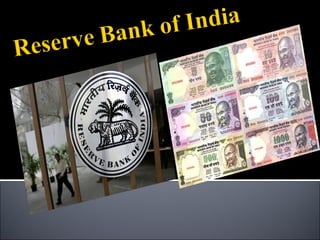
Reserve bank of india
- 2. It is the apex institution which governs the complete banking structure in India. The Reserve Bank of India (RBI) is India's central banking institution, which controls the monetary policy of the Indian rupee. The Reserve Bank of India was established on April 1, 1935 in accordance with the provisions of the Reserve Bank of India Act, 1934. The Central Office of the Reserve Bank was initially established in Calcutta but was permanently moved to Mumbai in 1937. The Central Office is where the Governor sits and where policies are formulated.
- 4. Though originally privately owned, since nationalization in 1949, the Reserve Bank is fully owned by the Government of India. The general superintendence and direction of the RBI is entrusted with the 21-member- Central Board of Directors —the Governor(currently Raghuram Rajan), four Deputy Governors, two Finance Ministry representative, ten government-nominated directors to represent important elements from India's economy, and four directors to represent local boards headquartered at Mumbai, Kolkata, Chennai and New Delhi.
- 6. The Preamble of the Reserve Bank of India describes the basic functions of the Reserve Bank as: "...to regulate the issue of Bank Notes and keeping of reserves with a view to securing monetary stability in India and generally to operate the currency and credit system of the country to its advantage."
- 8. Central Board of Directors: The Central Board of Directors is the main committee of the central bank. The Government of India appoints the directors for a four-year term. The Board consists of a governor, four deputy governors, fifteen directors to represent the regional boards, two from the Ministry of Finance and ten other directors from various fields. Governors: The current Governor of RBI is Raghuram Rajan. There are four deputy governors, Deputy Governor K C Chakrabarty, Anand Sinha, H R Khan andUrjit Patel. Deputy Governor K C Chakrabarty's term has been extended further by 2 years. Subir Gokarn was replaced by Urjit Patel in January 2013.
- 9. Supportive bodies: The Reserve Bank of India has ten regional representations: North in New Delhi, South in Chennai, East in Kolkata and West in Mumbai. The representations are formed by five members, appointed for four years by the central government and serve—beside the advice of the Central Board of Directors—as a forum for regional banks and to deal with delegated tasks from the central board. The institution has 22 regional offices. The Board of Financial Supervision (BFS), formed in November 1994, serves as a CCBD committee to control the financial institutions. The Tarapore committee was set up by the Reserve Bank of India under the chairmanship of former RBI deputy governor S. S. Tarapore to "lay the road map" to capital account convertibility.
- 10. Offices and branches: The Reserve Bank of India has four zonal offices. It has 19 regional offices at most state capitals and at a few major cities in India. Few of them are located in Ahmedabad, Bangalore, Bhopal,Bhubaneswar, Chandigarh, Chennai, Delhi, Guwahati, Hyderabad, Jaipur, Jammu, Kanp ur, Kolkata, Lucknow, Mumbai, Nagpur, Patna, and Thiruvananthapuram. It also has 9 sub-offices located in Agartala, Dehradun, Gangtok, Kochi, Panaji, Raipur, Ran chi, Shillong, Shimla and Srinagar.
- 12. The Reserve Bank of India performs this function under the guidance of the Board for Financial Supervision (BFS). The Board was constituted in November 1994 as a committee of the Central Board of Directors of the Reserve Bank of India. Some of the initiatives taken by BFS include: restructuring of the system of bank inspections introduction of off-site surveillance, strengthening of the role of statutory auditors and strengthening of the internal defences of supervised institutions. Current Focus supervision of financial institutions consolidated accounting legal issues in bank frauds divergence in assessments of non-performing assets and supervisory rating model for banks.
- 13. Monetary Authority Formulates, implements and monitors the monetary policy. Objective: maintaining price stability and ensuring adequate flow of credit to productive sectors. Regulator and supervisor of the financial system Prescribes broad parameters of banking operations within which the country's banking and financial system functions. Objective: maintain public confidence in the system, protect depositors' interest and provide cost-effective banking services to the public. Manager of Foreign Exchange Manages the Foreign Exchange Management Act, 1999. Objective: to facilitate external trade and payment and promote orderly development and maintenance of foreign exchange market in India.
- 14. Issuer of currency Issues and exchanges or destroys currency and coins not fit for circulation. Objective: to give the public adequate quantity of supplies of currency notes and coins and in good quality. Developmental role Performs a wide range of promotional functions to support national objectives. Related Functions Banker to the Government: performs merchant banking function for the central and the state governments; also acts as their banker. Banker to banks: maintains banking accounts of all scheduled banks.
- 15. Bank Rate (8.75%) Cash reserve ratio (CRR) (4.00%) Statutory Liquidity ratio (SLR) (23%) Repo Rate and Reverse Repo Rate (7.75% & 6.75%) Deposit Rate and Base Rate Reserve Bank Rate Marginal Standing Facility (MSF) (8.75%)
